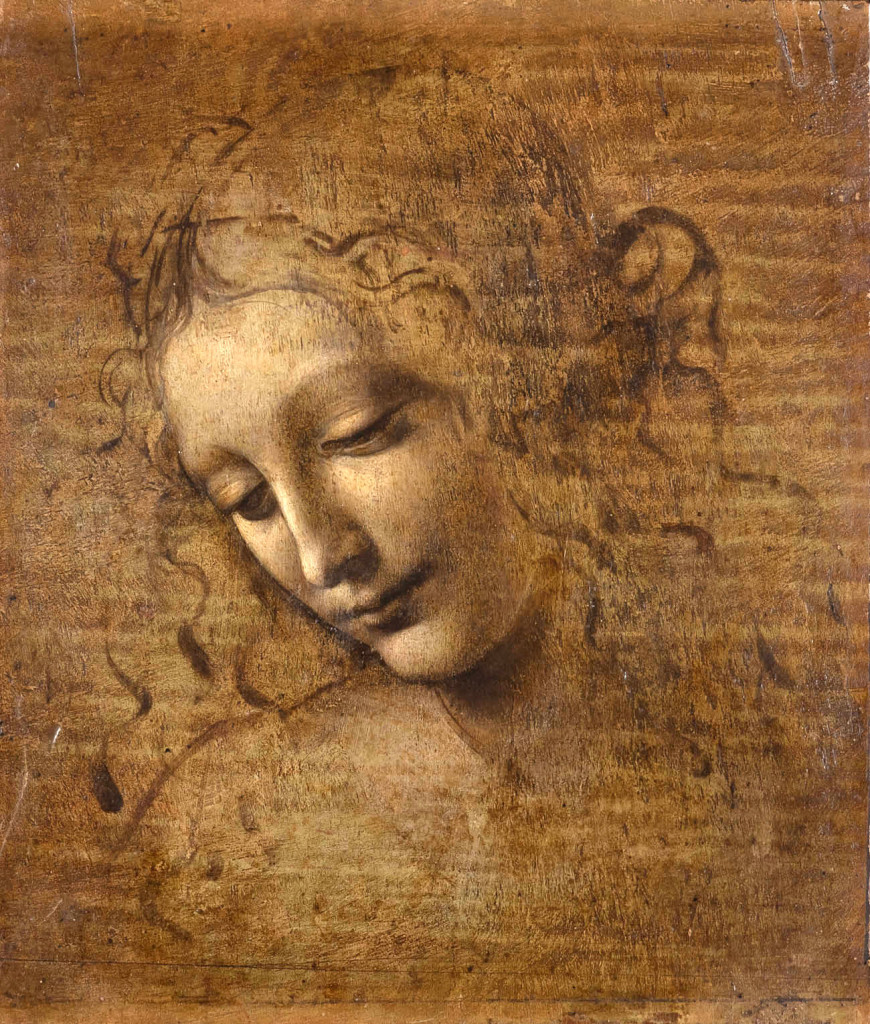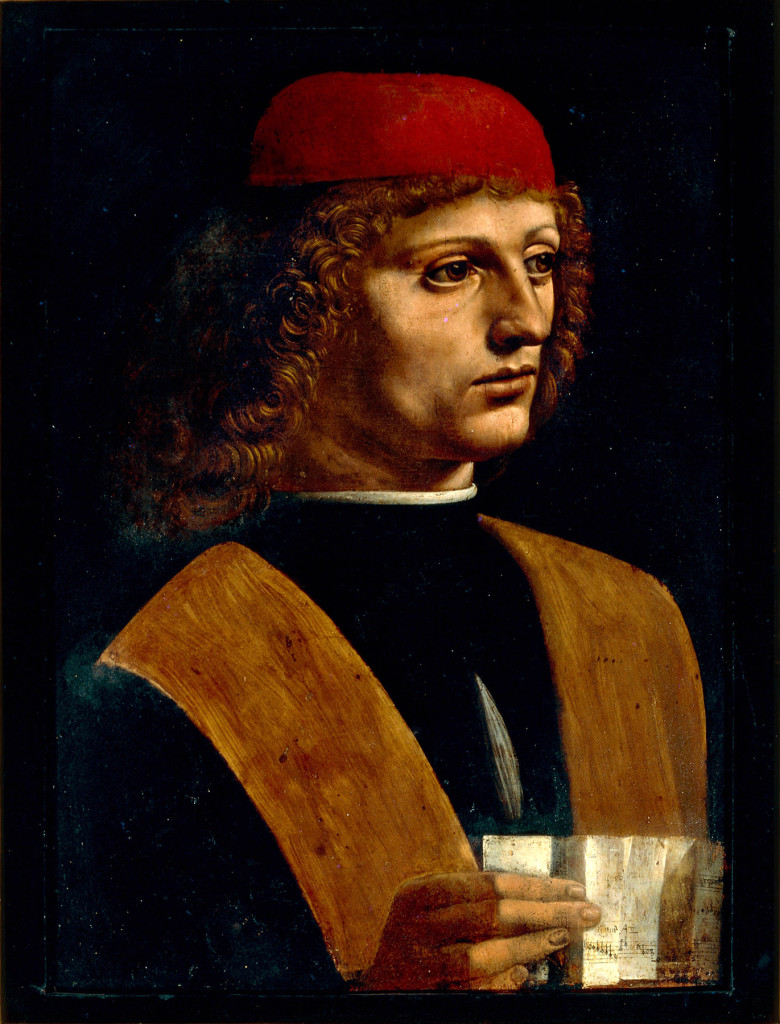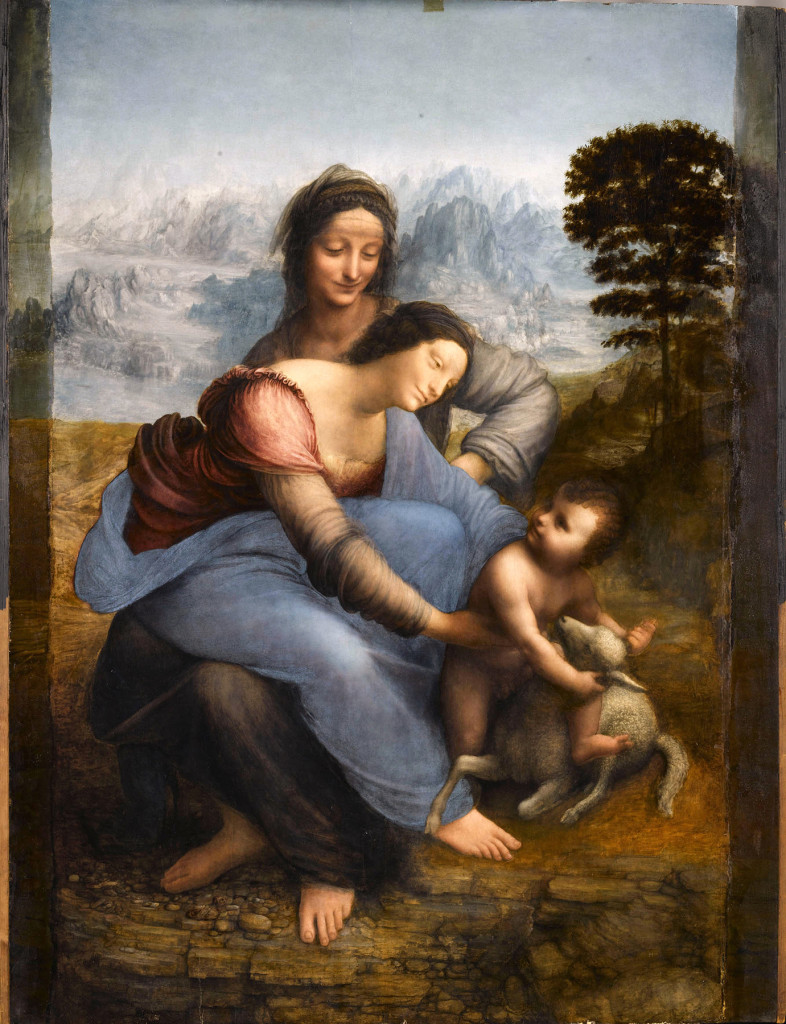
“Head of a Woman, called ‘La Scapigliata’” by Leonardo da Vinci. Licensed by Ministero dei Beni e delle Attività culturali — Complesso Monumentale della Pilotta-Galleria.
By Jessica Skwire Routhier
PARIS – Saudi princes. Right-wing nationalism. International diplomatic relations. Quid pro quo. Court battles, reluctant lenders, last-minute negotiations and lingering uncertainty about a key painting. And don’t forget the virtual reality headsets. It’s been called an “Italian soap opera,” even though France has been the lead actor. How will they keep visitors focused on the art? The subtly titled “Leonardo da Vinci,” commemorating the 500th anniversary of the artist’s death, is on view at the Louvre, in Paris, through February 24.
The ready answer, of course, is that the art is hardly ignorable. Leonardo (generally referred to, like most masters of the Italian renaissance, by his given name) produced some of the most globally recognized masterpieces of Western art of all time, including not only the Louvre’s “Mona Lisa” (1503) but also “The Last Supper” (1490s, convent of Santa Maria delle Grazie, Milan) and “Vitrivian Man” (circa 1490; Gallerie dell’Accademia, Venice), a drawing of a nude male figure inscribed within both a square and a circle, recognizable from Italy’s own one-Euro coin.
Only two of those three world-changing works of art will be on view in Paris – “The Last Supper” is physically part of the convent for which it was painted, so it cannot and has never been moved. But the Louvre’s victory in getting two of these works together under one roof, if not actually in the same room – along with 11 other paintings by Leonardo and 130-odd loans that have augmented its core collection of five paintings and 22 drawings by the artist – attests to its dogged, take-no-prisoners and ultimately successful approach to building this exhibition.
“Vitruvian Man,” in particular, represents a hard-fought battle. It was less than a month before the exhibition opened, on October 24, that an Italian court shot down a last-minute effort by Italia Nostra (“Our Italy”), an Italian nationalist faction, to block its loan to the Louvre. Leonardo was Italian, they said. Why should France benefit from Italy’s cultural capital?
Of course, it’s more complicated than Leonardo just being Italian. It’s true that Leonardo was born in the town of Vinci, in the Tuscan hills, and he spent most of his life in Florence and then Rome, and then Milan. But that was all 400 years before there was a unified Italy – and to further muddy the waters, he spent his final years as court painter to François I of France, residing and finally dying (on May 2, 1519) in Amboise. He kept the “Mona Lisa,” and the less renowned but equally bewitching “St John the Baptist,” with him to the end; long story short, this is how the French state came to be the beneficiary of what is the largest single collection of Leonardo paintings in the world.
So the stage was set for a showdown between Italy and France. Who gets to claim Leonardo?
What’s unusual about how that debate has evolved is that it was conducted less by curators and historians than by politicians. While a quincentenary Leonardo exhibition would certainly have been both appropriate and popular in Italy, as 2019 approached it nevertheless became increasingly clear that only the Louvre, with its unparalleled holdings, really had the resources to pull it off. This is partly because three of the Louvre’s five Leonardo paintings – the “Mona Lisa,” “Virgin of the Rocks” and “The Virgin and Child with St Anne” – are classified as “immovable,” meaning that they cannot be lent and can, therefore, be seen only at the Louvre. Further, two of the Louvre’s curators, Vincent Delieuvin and Louis Frank, had already been hard at work on studying their Leonardos, with a major exhibition in mind, for at least ten years.
Because the Louvre, as well as many of the Italian museums from which loans were sought, are state-funded, negotiations were initially hammered out during what the New York Times called a “Franco-Italian summit,” held in Lyon, France, in 2017. The resulting agreement, brokered by the respective countries’ culture ministers, ensured that Italy would send several works by Leonardo – including “Vitruvian Man” – and his followers to France for the 2019 show, while France would in turn send two major Raphael paintings to Italy for that artist’s quincentenary exhibition, at the Scuderie del Quirinale in Rome, in 2020.
But such state-level machinations are atypical for art loans, and what happened exposes the inherent risks. Within a year, the nationalist “Lega” (League) party had come into power in Italy, and the new secretary of culture, Lucia Borgonzoni, almost immediately took France to task for orchestrating an unfair deal, treating Italy with “a lack of respect,” and shopping its collections like a “supermarket” (as reported in the Times). “Probably no other country would dare” do this, she added. She found an unlikely ally in Italian museum directors, curators and conservators who had long held reservations about the deal struck in Lyon, protesting that some of the Italian works promised to the Louvre were also “immovable”; that others were too fragile to travel; and that, anyway, politicians shouldn’t be making decisions about cultural patrimony. “It’s a total Italian soap opera,” the director of the National Gallery of Parma told the Times.
The reemergence of a more centrist government in Italy, and the court decision earlier this fall, have guaranteed that the show can go on (though the Louvre would be well-advised to make good on its promise about the Raphaels). But uncertainty remains about one very high-profile painting that was eagerly sought for the exhibition. “Salvator Mundi (Savior of the World)” – a bust-length, devotional portrait of Jesus Christ holding a glass orb with his left hand and making a sign of blessing with his right – has a somewhat controversial attribution to Leonardo (the Louvre did not respond to questions about its authenticity), it was convincing enough for the painting to sell at Christie’s for $450 million in 2017. The purchaser, a member of the Saudi royal family, reportedly intended to display the painting at the Louvre’s Abu Dhabi wing; however, it does not seem to have been put on view there, and as of this writing, negotiations to bring it to the Louvre’s flagship location for this exhibition remain unresolved. Delieuvin and Frank confess that they have not actually seen the work since its sale and do not know where it is – some news reports have put it on a royal Saudi yacht – but they have included it in the exhibition catalog and have reserved a spot for it in the show, currently held by a painting on the same theme attributed to Leonardo’s studio.

“Portrait of a Young Man Holding Sheet Music” by Leonardo da Vinci. ©Veneranda Biblioteca Ambrosiana.
So the drama has, up to this point, overshadowed the work that is actually on view. Now that the exhibition is open to the public – it is expected to draw some 7,000 visitors per day – the Louvre has the opportunity to show why this has all been worth it; to demonstrate that to get so many works by the master and his contemporaries under one roof is about more than just a show of national strength or about drawing record crowds; to make a case that the exhibition has scholarly import as well as journalistic “legs.” Although its press office hasn’t seemed particularly interested in dismantling the perception of aloof entitlement that has plagued the organization of the show – they neither responded to interview questions nor provided a copy of the catalog, and their captions consistently refer to the artist as “Léonard de Vinci” – they of course know that the work speaks for itself. One may feel peevish about French politics and customer service, but a painting by Leonardo can never disappoint, and this is a once-in-a-lifetime opportunity to see the vast majority of them all in one place. No one needs convincing.
Delieuvin described the main idea behind the show, to the Times, as returning painting to its central role in interpreting Leonardo’s life and career. Over the last 50 years or so, the artist’s famous notebooks – which include anatomical drawings, inventions and scientific studies that are well ahead of his time – have become more known in the public consciousness, causing Leonardo to be seen as someone “who lived a somewhat dispersed life, dabbling in mathematics, geometry and every now and again painting.” But this isn’t really true, says Delieuvin, observing that every experiment and observation he made, every attempt to figure out how the world worked, was in service of his art. “His life was spent striving for the most perfect form of painting.”
Whether Leonardo achieved this or not is ultimately in the eye of the beholder. But over the last five centuries, few people have been wholly able to resist the precious few paintings that he left behind, somewhere between 15 and 20 by most counts. Here, the faces of Mary and the angel in “Virgin of the Rocks,” and of St John the Baptist in the eponymous painting that closes the show, radiate both ethereal beauty and wisdom. The massing of figures and interweaving of colors in “The Virgin and Child with St Anne” manages somehow to both look forward to modernism and back to medieval stained glass, while still being utterly of its time. Portraits like “La Belle Ferroniere” and “Portrait of a Musician,” not to mention the “Mona Lisa,” are such powerful conveyers of personality and psychology that they have been irresistible to biographers and Freudians alike. And then there are the landscapes – whole universes of dark trees, crystalline mountains, rivers, bridges, Florentine cityscapes, visible just beyond the shoulders of Mary, Anne and Mona – seemingly as much landscapes of the mind as of the known world.
The “Mona Lisa,” it bears noting, is not technically in the exhibition. So huge are the crowds that come to see this painting – upwards of 30,000 people per day – that there would have been no way to manage crowd control if it had been incorporated into the show. Instead, it will be on view in its regular location in the Louvre’s Salle des États, which is accessible on the same ticket as the Leonardo exhibition. To maintain a presence in the show for this most famous of Leonardo paintings, the organizers have worked with HTC Vive to create a virtual reality (VR) experience for visitors. With a VR headset on, visitors can take a virtual tour of the “Mona Lisa,” traveling as if in one of Leonardo’s flying machines from the crowded Salle des Ãtats to the inside of the painting, flying over Mona’s stone balcony and into the mountains beyond.

“St Anne, the Virgin, and the Christ Child, called ‘St Anne’” by Leonardo da Vinci. ©RMN-Grand Palais (Musée du Louvre). —René-Gabriel Ojéda photo
Not everyone is equally thrilled by the VR aspect of the show. Critic Didier Rykner observed acidly that “I would prefer the Louvre to be involved with reality”; such criticism is possibly aggravated more than mitigated by statements from the Louvre that such experiments are targeted at visitors who are “maybe not interested in the artworks” and from claims by HTC Vive representatives that Leonardo “would have loved” VR. But the VR space is segregated from the rest of the exhibition, which should otherwise be perfectly welcoming to more traditional visitors: dark walls, deep as one of Leonardo’s landscapes, with delicately lit drawings and paintings shining out from them like the faces of angels and saints.
The VR presence in the show, as well as the heavy dependence upon infrared radiography and digital imaging, for much of the scholarship and some aspects of the exhibition itself, somewhat complicates the message that it is essential to physically share space with these masterpieces. The “Mona Lisa,” hung well above eye level and crowded by selfie sticks, is barely visible in person; is that experience more elucidating than a virtual reality tour? For “Salvator Mundi,” will it be enough to see a lesser work, plus digital images of the original, to understand its significance in Leonardo’s oeuvre? Perhaps: some art historians, without ever having seen it in person and relying exclusively on detailed photographs, have even felt qualified to levy a judgment on its authenticity.
But if this were really about only images and not objects, if our fascination with Leonardo was really more about the workings of his mind than the works of his hand, then it seems doubtful that any country, any collection would feel as possessive and protective about their Leonardo as they clearly do. The drama and the negotiations may seem to have overshadowed the artwork thus far, but of course the drama has been all about the artwork to begin with: who has it, who wants it, who gets to fly their flag over it. The motivations may seem insufficiently lofty – and perhaps, at times, they have been – but in the end the passion and statecraft that have gone into the development of this show are a testament to Leonardo’s unmatched power as creator of paintings – of beautiful, challenging, revelatory works of art that need to be seen, wherever they are, to be believed.
The Louvre is on Rue de Rivoli. For additional information, https://www.louvre.fr/en or +33 (0)1 40 20 53 17.
















